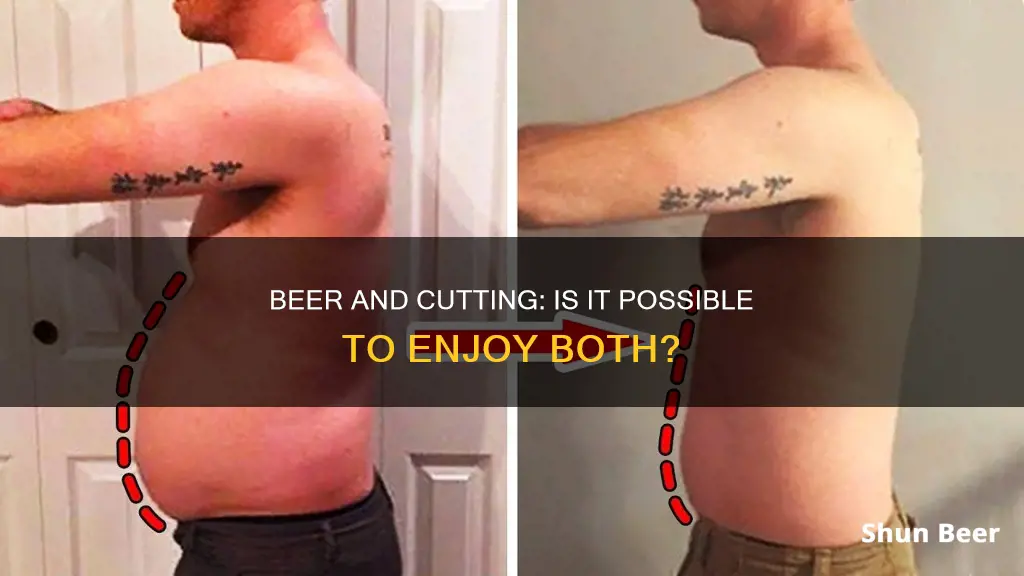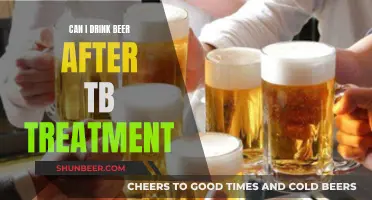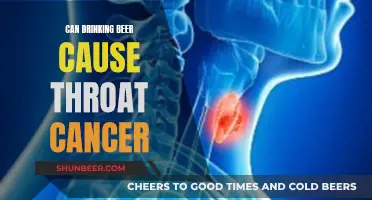
Drinking beer while cutting weight is generally not recommended, as alcohol is high in calories and can lead to poor food choices. However, some people choose to include a limited amount of alcohol in their diet while cutting, as long as they stay in a calorie deficit. The key is moderation, as excessive drinking can negatively affect recovery, performance, and muscle growth. It is important to be mindful of the number and type of drinks, as well as how drinking affects eating habits and overall progress.
What You'll Learn

Alcohol's impact on fat loss
Alcohol is highly calorific, with seven calories per gram versus four for carbohydrates and protein. It is also processed differently from other macronutrients, with the body identifying it as a toxin and working to remove it. This means that alcohol is burned for energy before fat and carbohydrates, which can lead to fat gain. Alcohol also increases appetite, leading to overeating.
However, alcohol does not directly cause weight gain and can be consumed as part of a calorie-controlled diet. A German study found that overweight subjects who consumed a glass of wine every day as part of a 1,500-calorie diet lost more weight than those who drank grape juice. Another study found that men who were given two vodka and sugar-free lemonade drinks experienced a 73% drop in lipid oxidation, but only 3-5% of the alcohol was turned to fat.
If you are trying to lose weight, reducing your alcohol intake can help, but it is not necessary to cut it out entirely. It is important to watch the number and type of drinks you choose and to be mindful of how drinking affects your eating habits. Health experts recommend drinking in moderation, which means no more than one drink per day for women and no more than two drinks per day for men. When drinking, it is a good idea to eat beforehand to help slow the absorption of alcohol and make better food choices.
Beer Drinking and Muscle Aches: Is There a Link?
You may want to see also

Alcohol's calorie content
Alcoholic drinks can be high in calories and can cause weight gain. A couple of drinks can add 500 calories or more to your daily intake. For example, a standard glass of wine can contain up to 158 calories, and a pint of stronger lager can contain up to 222 calories. A gram of alcohol contains 7 calories, which is almost as many as a gram of fat.
Health experts recommend that anyone who drinks should do so in moderation. This means no more than one drink per day for women and no more than two drinks per day for men. If you are trying to lose weight, you may want to drink less than that. It is important to plan your alcohol consumption into your daily calorie count so that you do not exceed your calorie limit for the day.
The calorie content of alcoholic drinks varies depending on the type of drink, the brand, and the serving size. Here is a list of the calorie content of some common alcoholic drinks:
- Regular beer: about 150 calories for a 12-ounce (355 mL) glass
- Light beer: about 100 calories for a 12-ounce (355 mL) glass
- Higher-alcohol or craft beer: 170 to 350 calories for a 12-ounce (355 mL) glass
- Wine: about 100 calories for a 5-ounce (145 mL) glass
- Distilled alcohol (gin, rum, vodka, whiskey): about 100 calories for a 1.5-ounce (45 mL) serving
- Martini (extra dry): about 140 calories for a 2.25-ounce (65 mL) glass
- Pina colada: about 380 calories in a 7-ounce (207 mL) glass
Cocktails mixed with soda, juice, cream, or ice cream can have especially high-calorie counts. It is important to be mindful of how much you drink and to understand the calorie content of your favourite beverages.
Non-Alcoholic Beer: Safe for Liver Disease Patients?
You may want to see also

Drinking in moderation
Alcohol has empty calories—calories that provide your body with energy but have no nutritional value. A gram of alcohol has 7 calories, compared to 4 calories per gram for carbohydrates and protein. This means that when you drink alcohol, you are replacing potentially nutritious, filling food with calories that will not satisfy your hunger.
If you want to drink beer while cutting, you need to plan it into your daily calorie count so you do not exceed your total calorie intake for the day. You can do this by eating less food or doing extra cardio to offset the calories from the beer. However, be aware that drinking on an empty stomach will make you feel tipsy more quickly, which can lead to drinking more than you intended. It can also lead to poor food choices when you drink.
If you are serious about cutting, you may want to consider cutting out alcohol altogether, as it can hinder your progress. Alcohol is calorically dense and can temporarily slow down fat metabolism. It is also a diuretic, which can lead to dehydration and further negatively impact your workouts.
In conclusion, while it is possible to drink beer in moderation while cutting, it is important to be mindful of the number of drinks you are consuming and to plan them into your daily calorie intake.
Vodka and Beer: Mixing Alcohol Safely and Responsibly
You may want to see also

Alcohol's effect on muscle growth
Alcohol's Caloric Content and Its Impact on Muscle Growth:
- Alcohol is high in calories, with 7 calories per gram, which is higher than carbohydrates and proteins, which have 4 calories per gram.
- Alcoholic drinks, especially mixed drinks, can contain as many calories as a meal but without the same nutritional value.
- When consuming alcohol, it is important to be mindful of the number and type of drinks and their calorie content.
- To drink alcohol while cutting calories, it needs to be planned into your daily calorie count to ensure you don't exceed your limit.
The Role of Protein Synthesis in Muscle Growth:
- Muscle growth depends on a balance between protein synthesis and protein breakdown.
- Alcohol inhibits muscle protein synthesis, disrupting the signalling pathways that tell the body to build muscle.
- Studies have shown that alcohol consumption can reduce muscle protein synthesis by up to 37% when consumed after exercise, even when combined with protein intake.
- However, one study suggested that alcohol consumption with protein reduced MPS by 24%, indicating a partial recovery of MPS when alcohol was consumed with protein.
Alcohol's Impact on Hormones and Their Role in Muscle Growth:
- Alcohol affects testosterone levels, with both acute and chronic ingestion leading to lower testosterone levels.
- Alcohol use can damage the cells that produce testosterone and cause inflammation, suppressing testosterone production.
- Reduced testosterone in men can have several negative consequences, including decreased libido, diminished muscle growth, and an increased risk of osteoporosis.
- Alcohol can also increase estrogen levels in men, leading to potential feminizing effects such as loss of erection, sore nipples, testicular atrophy, and other symptoms.
- Additionally, alcohol increases cortisol levels, which can contribute to tissue breakdown if elevated for extended periods.
Alcohol's Effect on Sleep and Muscle Recovery:
- Alcohol can disrupt sleep patterns, particularly REM sleep, leading to daytime drowsiness, exhaustion, and weak concentration.
- Sleep is crucial for muscle recovery and tissue repair, and inadequate sleep can negatively affect strength and athletic performance.
- However, moderate alcohol consumption (1-2 drinks) is not expected to disrupt sleep patterns significantly.
Practical Considerations for Drinking While Cutting:
- Health experts recommend drinking in moderation, which means no more than one drink per day for women and no more than two drinks per day for men.
- Binge drinking and excessive alcohol consumption are not conducive to muscle growth and can lead to various health problems.
- If your goal is to achieve a specific physique, it is possible to include occasional alcohol consumption in your fitness plan without negative effects on your results.
- To minimize the impact of alcohol on your fitness goals, it is advisable to make healthy choices, maintain a balanced diet, and ensure adequate nutrient intake.
Beer and Vitamins: Can They Mix?
You may want to see also

Alcohol and appetite
Alcohol is high in calories and provides 7 kcal of energy per gram, making it more energy-dense than carbohydrates or protein. Alcoholic drinks can contain a significant number of calories, and studies have shown that an average adult can get up to 10% of their daily caloric intake from alcohol alone. Alcohol also affects your energy intake in other ways. For example, it makes us feel hungrier once we start eating, and it can reduce how satiated or full we feel after a meal. This is because alcohol inhibits the secretion of leptin, a hormone that helps us feel full.
The effects of alcohol on our appetite and fullness are complex and vary depending on the type of drink, our associations with certain drinks, and other factors. For instance, you may associate red wine with good meals and, therefore, be more inclined to eat more when drinking it. On the other hand, you may eat less after drinking champagne because you associate it with hangovers. The carbonation in some drinks or the alcohol itself can also numb your mouth and dull your sense of taste.
It's important to note that drinking alcohol can lead to poor food choices and increased calorie consumption. This is because alcohol clouds your judgment and doesn't affect satiety like other nutrients. As a result, you may end up eating more than you normally would, especially if you drink on an empty stomach.
If you're trying to lose weight, cutting back on alcoholic drinks can boost your efforts. However, you don't have to completely eliminate alcohol from your diet. Instead, consume it more mindfully by watching the number and type of drinks you choose, and pay attention to how drinking affects your eating habits.
Wellbutrin XL and Beer: Is It Safe?
You may want to see also
Frequently asked questions
Yes, but only in moderation. Alcohol is high in calories and can cause weight gain. It is recommended to stay in a calorie deficit to lose weight.
It is recommended to limit alcohol consumption to no more than 1 drink per day for women and no more than 2 drinks per day for men.
Lower-calorie options such as spirits, cocktails, wine, or light beer.
Yes, as long as you stay in a calorie deficit. Alcohol does not directly convert into body fat, but it can hinder fat metabolism and increase appetite.







